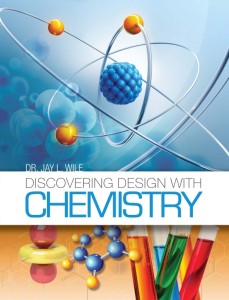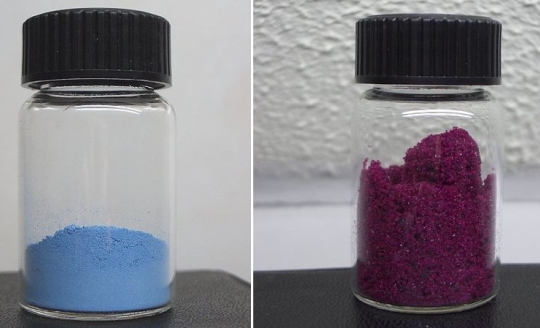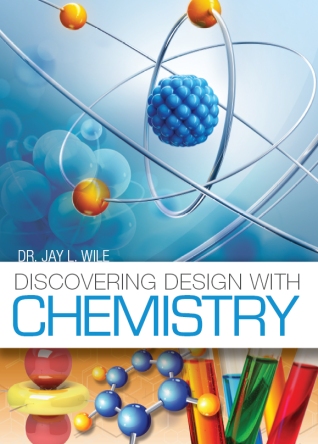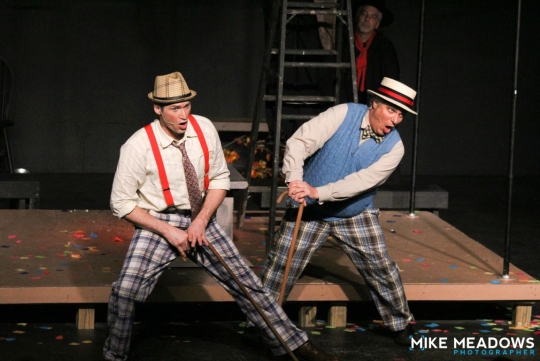
I was recently asked on Facebook about the differences between my old chemistry course and my new one. While I have touched on that issue in a couple of other posts, I thought I would provide a thorough answer to that question here.
Thoughts from a scientist who is a Christian (not a Christian Scientist)

I was recently asked on Facebook about the differences between my old chemistry course and my new one. While I have touched on that issue in a couple of other posts, I thought I would provide a thorough answer to that question here.

This young lady has been homeschooled since kindergarten, but that’s not why my Facebook friend posted the news story on my wall. If you watch the video, at the 18-second mark, you will see Miss Van Iderstine pulling books out of her backpack. The first one that comes out is the second edition of Advanced Chemistry in Creation, which is one of my books. While it was neat for me to see that, it’s not why I am writing about this amazing young student. There are several things in the news story that really impressed me about her, and the perfect ACT score relates to only one of them.
I learned that Miss Van Iderstine received a score of 32 when she first took the test. As the newscaster says, that’s a great score. It is within the range found among the majority of students who go to Harvard. However, this young lady was not satisfied. She wanted to do better, so she took the test a second time, and that’s when she got her perfect score. I know a lot of students who would have stopped after getting a 32 on their first try. After all, that’s a great score, and most students are happy with a great score. However, this young lady thought she could do better, so she studied and tried again. It clearly paid off.
Continue reading “Homeschooled Student Gets Perfect ACT Score”

This new chemistry course is completely different from the previous one I wrote, Exploring Creation with Chemistry, 2nd Edition. It covers the standard college-prep chemistry topics in a different order, but more importantly, it emphasizes aspects of those topics in a way that makes them more relevant to this decade. For example, when discussing Dalton’s Atomic Theory, I point out that he used his theory to predict something about the masses of two elements that can react to form completely different compounds. That prediction was later confirmed, and we now call it “The Law of Multiple Proportions.” I point out that a theory can’t be considered scientific unless it can make such predictions. I then discuss this in the context of creation science. I talk about how the scientific theory of creation has been used to make many successful predictions, including the fact that there is very little “junk DNA” in the human genome.
The most important difference between the courses, however, is the experimental component. When I wrote the older course, I had the students perform the best experiments they could with reasonably-priced equipment. Since that book was written, however, the cost of certain chemistry equipment, such as precise mass scales, has gone down significantly. As a result, what is available at a reasonable price today is quite different from what was available back when the old course was written. Because of this, the experiments are significantly better in this new course.
For example, there are certain chemicals that tend to incorporate water into their solid phase. We call them hydrates. Consider the picture below:

You might think these are two different compounds, but they are not. Both jars contain cobalt (II) chloride. The reason they look different is because the solid on the left has no water in it. As a result, we call it the anhydrous form of cobalt (II) chloride. The solid on the right has water in it, so we call it the hydrated form of cobalt (II) chloride. Both solids perform exactly the same chemistry. The only difference between them is the presence of water.

I spent this past weekend in Ontario, California, speaking at the California Homeschool Convention, which is part of the Great Homeschool Conventions series. There are a lot of wonderful things I could say about the Great Homeschool Conventions, but the thing I most appreciate is the eclectic mix of speakers they invite. You see all the “standard” speakers from the homeschooling circuit, such as Jim Weiss, Andrew Pudewa, and Heidi St. John, but you also see speakers that aren’t typically a part of a homeschool convention. This year, for example, they had Holocaust survivor Inge Auerbacher as a speaker. I interviewed her before the first convention, and I later reported on her talk at the convention, which was nothing short of incredible.
The other interesting speakers they had this year were mother/son team Kristine and Jacob Barnett. I didn’t get a chance to hear them at the other conventions, but since this was my last opportunity, I made a point to go to their talk. I am so glad I did! If you have not heard about them, Jacob was diagnosed with autism when he was two years old. His mother (Kristine) initially followed all the experts’ advice, which ended up meaning hours of therapy for Jacob every day. Eventually, however, she decided that all this therapy was robbing Jacob of his childhood. As a result, she stopped all the therapy and simply played with him. She blew dandelion puffs in his face, listened to music with him, and helped him search for patterns in the clouds.
She found that this was helping him much more than therapy, so she started encouraging other mothers of autistic children to do the same. In fact, she was so sure that this kind of nurturing was the best “therapy” autistic children could get, she began working with other autistic children. Her goal was simple: just enable them to do what they really wanted to do. She would get them what they needed, and she would simply help them do whatever it was that interested them. For some, this meant making robots. For others, it meant creating amazing paintings. For another, it meant chasing storms and trying to analyze them. In her own words:
I was not teaching them. I was letting them.
I don’t know much of anything about child development, especially when it comes to children with special needs. Thus, I have no idea how effective her strategy would be for most autistic children. However, she says that it was very effective for those that she helped. I can tell you for certain that it was effective for her son, Jacob, because his talk was one of the best I have heard in a long time.
Continue reading “The 2015 California Homeschool Conference: Wisdom from Jacob and Kristine Barnett”

I spent this past weekend speaking at the Homeschool Iowa Conference. I had never been to this particular homeschool conference before, and I am so glad I got to go this year. The attendance was excellent, the conference ran smoothly, and the organizers treated the speakers incredibly well. My publisher’s booth was right across from Heidi St. John’s booth, and for the first time in quite a while, I got to spend some time talking with her and her husband, who has the world’s best first name (Jay). They are both wonderful servants of God, and spending time with them is a real blessing.
I gave six talks at the conference: Homeschooling: The Solution to our Education Problem, ‘Teaching’ Science at Home, Building a Biblical Worldview, Ecohysteria, Creation Versus Evolution, and What I Learned by Homeschooling. They were very well attended, and I got some excellent questions afterwards. I also spent a lot of time taking with individuals, including several very impressive homeschooled students.
One particularly impressive student was a junior in high school. After one of my talks, she asked me to sign a couple of her books. I noticed that one of them was my advanced chemistry course, which is essentially AP-level chemistry. I told her that I was impressed she was taking advanced chemistry, and she told me that she had already taken my biology, chemistry, and physics courses as well as a Human Anatomy and Physiology course. Once she finished advanced chemistry, she planned to take advanced physics. This means that by the time she graduates, she will have covered the equivalent of three AP-level science courses in high school! I told her how impressive that is, since many high school students don’t even take one AP-level science course. She was quite humble, however, brushing aside my praise and simply telling me that she really enjoys studying science.
Another student and his family spoke to me about their experience with the third edition of Exploring Creation with Chemistry. As you might know, I don’t recommend that edition to anyone because of its many scientific errors and its habit of requiring students to know things they have not yet been taught. The student told me that he had started with the third edition of the the course, not knowing that I wasn’t the author. As he tried to cover the material, he got more and more confused. Eventually, he realized that my name wasn’t on the book, so he got online and found a used second edition of the course (which was authored by me). When he used that edition, he understood and enjoyed the material. I told him I was very sorry that he had to do that and, unfortunately, there are probably many students who have found themselves in a similar position.

Once again, there has been a long pause in blog entries because I am working hard to finish my new high school chemistry course so it will be ready for those who want to use it during the upcoming academic year. I just finished the rough draft of the course, and my reviewers are running ahead of schedule. Thus, it looks like the course will be ready on time. I truly hope it meets the needs of homeschoolers who want a college-preparatory, scientifically-sound, and homeschool-friendly general chemistry course.
Even if you aren’t in need of a high school chemistry course, you might be interested in the way that I start and end my text, because it involves the views of two people who know more about science than I ever will know. I start with Dr. Arthur Leonard Schawlow, who shared the 1981 Nobel Prize in Physics with Nicolaas Bloembergen and Kai Siegbahn for his work on laser spectroscopy. In addition to that high honor, Dr. Schawlow was awarded the National Medal of Science, the Stuart Ballantine Medal, the Young Medal and Prize, and the Frederic Ives Medal. As a fitting tribute to him, the American Physical Society established the Arthur L. Schawlow Prize in Laser Science.
As part of a project developed by Dr. Henry Margenuau and Roy Abraham Varghese, Dr. Schawlow was asked, “What do you think should be the relationship between religion and science?” Here is his part of his reply:1
But the context of religion is a great background for doing science. In the words of Psalm 19, “The heavens declare the glory of God and the firmament showeth his handiwork.” Thus scientific research is a worshipful act, in that it reveals more of the wonders of God’s creation.
I strongly agree with Dr. Schawlow. Using science to study God’s creation is what led me to believe in Him, and every time I learn something new about His creation, I am filled with awe and wonder.
I use Dr. Schawlow’s quote in the introduction to my chemistry book to let students know that science is more than just an academic exercise. It is a way to come to a deeper appreciation of God’s majesty and power.

This past weekend, I spoke at the Michigan Home Education Conference. It might have been the very first time I have spoken at this convention, even though it has been going on for quite a while. It was held in the beautiful Lansing Center (pictured above), and the weather was quite nice, so I got an opportunity to enjoy the conference center’s riverfront setting. When I wasn’t outside enjoying the view or talking with people at my publisher‘s booth, I was giving talks. I gave a total of six talks at the convention: Homeschooling: The Solution to our Education Problem, ‘Teaching’ High School at Home, Teaching Science at Home, Be Open-Minded, but Don’t Let Your Brain Fall Out, How to be a REAL Environmentalist, and Why Homeschool Through High School.
The conference was well attended and ran quite smoothly. One interesting thing this conference does is offer a free session on Thursday night. It is designed for those who are thinking about homeschooling their children, but in the end, anyone is welcome. The first speaker of that session was Carol Barnier, and she was a delight to hear. She spoke about the basics of homeschooling, and she had one of the best phrases I have heard regarding the homeschool model:
Homeschooling is incredibly efficient and forgiving.
It is efficient because the education is tailor-made for the child. As a result, the child can learn a lot more in a set amount of time than one who must sit in a classroom that attempts to meet the needs of all the students there. It is forgiving because it is so efficient. It might take you several years to find the ideal educational approach for each of your children. However, once you find what works, each child learns so efficiently that it doesn’t matter if you wasted a few years. In the end, the child will “catch up” and eventually surpass what he or she would have accomplished in a classroom setting.
I wholeheartedly agree with Carol. Homeschooling is incredibly efficient and forgiving, which is why homeschooled students are so outstanding, especially those who were homeschooled K-12.

I wanted to use this blog post to give you an update on the course. I am just over three-fourths of the way done with my rough draft, and my reviewers are keeping pace with me. As a result, I currently see no problem with meeting the deadline. This means that, barring some unforseen circumstances, the course will be available on August 17th of this year. Thus, if you are looking for a homeschool-friendly, college-preparatory chemistry course for this coming year, you can consider using my new course.
To get an idea of the course content, look at the table of contents as it exists so far. You will see that after a necessary discussion of measurement, units, and significant figures, I introduce students to the classification of matter. Then, I discuss atoms and molecules, so students learn how matter is constructed. This leads to a discussion of molecular geometry as well as the distinction between chemical and physical change. After a brief discussion of physical change, most of the rest of the course concentrates on chemical change. The students learn about several different types of chemical reactions (formation, decomposition, single and double displacement, combustion, acid/base, and reduction/oxidation), and along the way, they learn one of the most important concepts in all of high school chemistry: stoichiometry. In case you don’t know that term, it is the process by which you can calculate the quantities of substances in a chemical reaction. In addition to all that, the students learn about solutions, gases, heat and its effect on matter, the energy associated with chemical reactions, the speed of chemical reactions, and chemical equilibrium.
While the topics covered in this course can be found in pretty much any college-preparatory high school chemistry course, there are three things that separate this course from the other ones that are currently available.

On Friday and Saturday last week, I spoke at the Ontario Christian Home Educators’ Convention in Ontario, Canada. It has been 10 years or more since I last spoke there, so it was nice to be back. The convention was held on the campus of Redeemer University College in Ontario, where the admissions director is a home educator. Like many universities, Redeemer has learned that homeschool graduates make above-average university students (see here, here, here, here, and here), so they actively encourage homeschool graduates to apply. They are also happy to support homeschooling in Canada.
The convention was very well attended, and based on a show of hands at my keynote session, about 20% of the attendees had never been to a homeschool convention before. As I spoke with individual attendees, it became clear that several of the people at the convention were considering home education for the first time. When I mentioned this to one of the conference organizers, he indicated that the new premier of Ontario is introducing a radical sex education program, and it is causing many in Ontario to look for a way out of the government school system. Based on what I read about the new program, I truly hope lots of parents remove their children from such a horrible situation!
I gave a total of six talks at the convention: Homeschooling: The Solution to our Education Problem, Be Open-Minded, but Don’t Let Your Brain Fall Out, What About K-6 Science?, Why Homeschool Through High School, ‘Teaching’ High School at Home , and How are Homeschool Graduates Doing? When I give talks in a different country, I always try to make them relevant for that country, so most of the statistics I shared came from Canadian education studies, and most of the experts I quoted in my talks were Canadian. The conference organizers really appreciated that. I guess some U.S. speakers come to Canada and just assume that all of their U.S.-based talks are relevant to Canadians, and some of them just aren’t.
One thing I have to note is that this convention really knew how to make an out-of-the-country speaker feel right at home. They arranged for me to have a home-cooked dinner the night that I arrived, and it was great! The couple who hosted me had three charming children, two of whom colored pictures for me. Those pictures are now on my bulletin board in my office. Then, each morning, another couple cooked breakfast for me. The other meals were catered by Redeemer University College. Everyone made sure I had everything I needed to be as comfortable as possible. I don’t get pampered like that very often, and it was really nice!
Continue reading “The Ontario Christian Home Educators’ Convention”

This past weekend, I spoke at the 2015 Midwest Homeschool Convention. I gave a total of six talks. Four of them were solo talks: Creation versus Evolution: Religion versus Science or Religion versus Religion?, What I Learned by Homechooling, Reasonable Faith: The Scientific Case for Christianity, and College and Faith: What’s The Real Story? I also gave two talks with Diana Waring: Homeschooling: Things We Wish We Had Known and Dealing with Pressure: The Benefits of Slowing Down. The conference was very well attended and ran quite smoothly.
I did learn one sad thing, however. Diana Waring announced that she is retiring from the homeschooling conference circuit. She will still be writing, but she will not be speaking at homeschool conventions on a regular basis anymore. The homeschooling community will be missing out on some real blessings as a result. If homeschoolers want to continue to benefit from her wisdom, they should follow her blog.
I didn’t have the chance to speak to as many people as I usually do at such conventions, because I am currently performing in a musical called The Fantasticks. As a result, I had to drive a bit more than two hours from Anderson, Indiana to Cincinnati, Ohio every morning to speak at the convention, and then I had to leave the convention early so I could drive back to Anderson, Indiana to perform in the play. Normally, I wouldn’t consider doing such a crazy thing, but this is my all-time favorite play. I have performed the roles of El Gallo (my all-time favorite role) and Henry (a washed-up actor), and in this version of the play, I got a chance to perform a different role, Amos Babcock Bellomy (a nerdy father). The role was played by Joel Grey in the movie, and I simply couldn’t pass up the opportunity. Here is a picture of me during one of the performances (I am the one in the bow tie):
